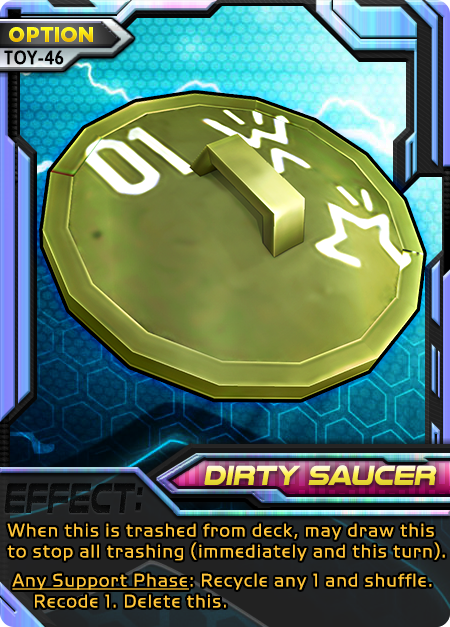
Dirty Saucer—Garbagemon’s signature shield and yours too.
What’s good about it: You get to draw this to hand, so it’s an extra free card. Stops all trashing and I do mean all. Right in the middle of it. Even if you are supposed to Trash 7 but you only trashed like 2, you stop immediately. Even the opponent’s trash costs won’t be able to be paid for the rest of the turn. Now you can use highly detrimental cards like [card img=”https://www.v-mundi.com/wp-content/uploads/2020/11/009-BigMamemon.png” name=”Bigmamemon”] with a much softer blowback. Even the almighty [card img=”https://www.v-mundi.com/wp-content/uploads/2016/08/177-Warp-Dimension.png” name=”Warp Dimension”] becomes a foam dart gun because Dirty Saucer only stops the trashing, it doesn’t void the support that caused the trashing. In fact, many opponent cards may misfire (self-void) even if they are unvoidable, since cards can always void themselves. Once it’s in your hand, you can put anything from your trash back in the deck plus a recode after. What’s bad about it: Chance. Once you want this to get trashed, you may not get it. Or you might just draw it. A self-destructive or reckless player may find themselves without their shield in a time of need, with tons of cards blown away into their trash zone. It’s also really hard to use in a deck with trash costs. If you say you are trashing 3 for a cost then the second card is dirty saucer, you only count as having trashed 2 cards. Depending on the effect, this can misfire after you’ve already paid. You can suppress the misfire but it means skipping Dirty Saucer. The “Any Support” effect does delete itself, so is very fleeting and must be used wisely. You should check if this actually affects your game anyway, since you might use it a few times in the lifespan of a deck but not actually see the benefits unless you also change how you play. Every slot this takes up in a deck could’ve been a much more powerful card. Options are vying for limited and highly competitive space within a deck, so Dirty Saucer’s lack of “killer app” potential could make it a flop in your deck. Plus, if you really want to stack the recode, the shuffle beforehand is going to hurt all your other recodes. Tips: Maybe you noticed, but the act of trashing should happen 1 card at a time to keep a player’s trash zone in the correct order (bottom to top). This allows crazy cards like Dirty Saucer to exist and effectively interrupt that process as soon as it shows. Be aware that “both players trash X” effects should happen simultaneously, so make sure to react in a timely manner if your Saucer happens, to prevent any game state rollbacks. While not every deck can use this with maximum copies (and bypass much of the negatives), a deck using the Mantra mastery (for shuffle recode) can exploit the shuffle effect on Dirty Saucer to maximum potential without also increasing its own risk too heavily. Look for effects like Tueryemon that have trash costs but have more than 1 effect so your entire support doesn’t misfire if you get Dirty Saucer. Try using Recycle on it to guarantee you get the nullification next time you would trash, then have some extra draw ready in case you don’t. Recode can be a downside but also help you know when the Saucer is coming. The best part may be getting trashed a lot before seeing this, especially since the “Recycle any 1 and shuffle” part will only be putting your best card back in a much thinner deck and this can be combined with other similar effects for a deadly lean-machine deck. Because Digimon doesn’t really have a “meta”, I wouldn’t recommend Saucer for trash countering but I would suggest a copy or two if your own deck is self-destructive or very weak to such things. Keep an eye on your Ace and you may be able to retrieve it with Saucer and simply mulligan until you get the Ace, if that suits the current game.
Leave a comment